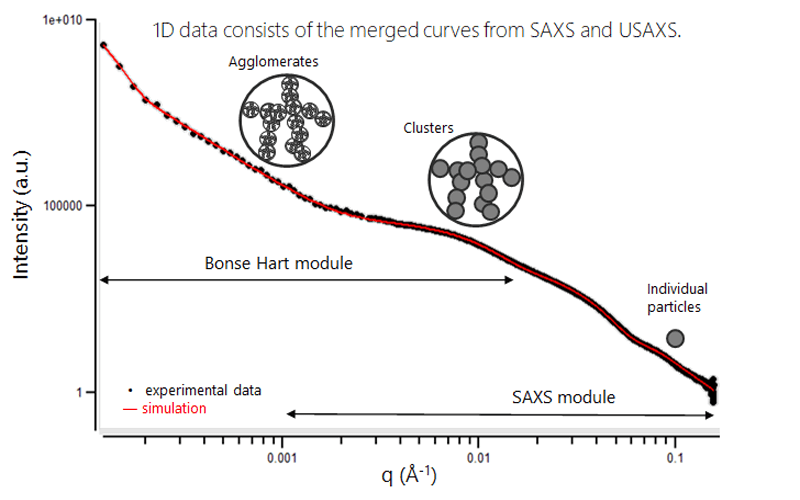– Application highlight –
纳米复合材料是一类高性能材料,在各个行业都引起了人们的关注,例如汽车行业。它们包括一系列低成本但高性能的材料,具有对汽车制造有价值的机械、热和加工性能。这些整体性质由纳米尺度上的结构决定,因此,小尺度结构的准确分析对于纳米复合材料的表征和开发至关重要。X 射线散射技术可以对影响纳米复合材料性能的许多参数提供前所未有的洞察力。
纳米复合材料是由一种或多种材料组成的纳米颗粒或纤维(填充物)分散在大块(基体)材料中的复合材料。填料和基体都保留了它们本体材料的特性元素,而填料的纳米级参数为纳米复合材料提供了新的特性。这些参数包括填料颗粒的分散、形状、取向和尺寸分布,以及它们与本体基质的相互作用[1-4]。因此,纳米复合材料是一种非常广泛的材料,在生产过程中可以通过改变组成材料的物理和化学性质来精细地调整其性能。
通过显微镜对此类材料进行分析,可以获得复合材料中纳米颗粒的各个几何形状的有用信息;然而,它无法提供有关纳米颗粒尺寸分布和体积分数的统计信息。因此,显微技术无法对较大样本体积中的变化提供有意义的表征,这却是影响材料实际服役效果的关键信息之一。此外,许多纳米复合材料对可见光不透明或需要复杂的样品制备,这极大地限制了显微镜分析的效果。

利用SAXS表征纳米复合材料
小角X射线散射 (SAXS) 为纳米复合材料中纳米粒子的统计分析提供了解决方案。SAXS使用 X 射线散射来确定具有统计意义的体积(通常约为1mm3)内的纳米级参数,例如纳米复合材料中纳米颗粒的尺寸分布[8]。
下面的图1举例说明了用SAXS测量一个利用新策略制造的具有高度有序层状结构的纳米复合材料[6]。

Figure 1 – 通过剪切流诱导纳米片排列(超铺展)的新方法制备的基于粘土/CNT的纳米复合薄膜的 X 射线散射测试结果和机械性能。图1a: 不同浓度的纳米填料(wt%)的X射线散射强度随方位角的1D图,取向度有序参数和纳米片层间距离(未显示,请阅读原文)。图 1b:不同纳米复合材料的相应应力-应变曲线。图片来自 Nature 580,210–215 (2020) (Supplementary Data)。文中数据采集于法国Xenocs公司的Xeuss小角/广角散射线站,配备的是Genix3D铜靶光源。
汽车行业:利用SAXS表征多尺度填料结构
汽车行业对燃油经济性和低排放的需求增加了对车辆轻质结构材料的需求,纳米复合材料提供了有吸引力的解决方案。采用纳米复合材料可以在不影响结构的情况下,显着减轻重量,提供与金属相当或更优越的可靠性。此外,纳米复合材料的独特性能可以为非结构部件带来许多理想的性能;包括提高耐用性、降噪和耐腐蚀性。[5]还可以通过使用纳米复合材料来实现额外的功能特性,例如紫外线屏蔽。
汽车轮胎[7]是纳米复合材料在汽车工业中广泛应用的一个例子。通过使用纳米复合填料(通常是二氧化硅纳米颗粒或炭黑),可以实现并增强轮胎所需的极端耐用性,这些填料的橡胶已被证明比未填充的橡胶聚合物具有更高的强度和抗变形性。对橡胶中二氧化硅团簇的分析促进了用于制造轮胎的新材料的开发。
要完整而有意义的了解纳米复合材料特性,需要在一系列长度尺度上进行分析:从纳米粒子的表面结构到其整体几何形状,从纳米粒子簇到各种尺度的团聚体。 标准的 SAXS 设备能够测量单个颗粒和颗粒聚集体的回转半径(尺寸指标)。而使用 Bonse-Hart 超小角X 射线散射 (USAXS) 配置,可以测量更大的长度尺度并获得有关团聚体的信息,如下图所示。

Figure 2 – 橡胶中二氧化硅簇的SAXS和 USAXS结合实验曲线(在 Xeuss 上进行的连续自动测量)和多尺度拟合模型,图形插入显示分析的不同类型的颗粒。
在这种情况下,对曲线的模拟获得了关于单个颗粒尺寸以及团簇和聚集体尺寸,以及3个长度尺度的分形维数信息。
使用标准模型分析结果的速度很快,特别适用于比较样品的不同配方参数。此外,还开发了工业纳米复合材料复杂填料结构的定量模型。例如,将扫描电镜 (TEM) 等高性能显微技术与 SAXS 结合使用,除了完整的层次结构外,还可以对聚集体间相互作用、聚合多分散性和密实度进行全面表征[9]。
Xenocs的Xeuss是用于实验室的高性能SAXS表征线站,旨在促进用于软物质和纳米材料分析的超小角、小角和广角 X 射线散射分析。它可以快速表征纳米复合材料中的填料网络,例如生物橡胶[10]、橡胶炭黑填料[11]、或氧化石墨烯与聚(乙烯丙烯酸甲酯)[12]。
Xeuss小角X射线散射仪拥有高度灵活的配置,可覆盖从纳米级到亚微米级的广泛尺度范围:其基础系统可测量从几纳米至350纳米的颗粒尺寸分布,配合Bonse-Hart超小角散射附件(USAXS)更能实现4微米以上大尺度结构的表征。在提供前沿分析性能的同时,该仪器始终贯彻用户友好理念:不仅支持全远程操作配置,其大型真空腔体结合测量过程中样品静止的设计,更确保了设备在各类复杂研究场景下的极致适用性[13]。
Discover other Xenocs SAXS instruments on Xenocs product page, and especially the Nano inxider8 for SAXS, WAXS and GISAXS studies on all types of samples.
References and Further Reading
- Genix, A.-C., Bocharova, V., Carroll, B., Lehmann, M., Saito, T., Krueger, S., He, L., Dieudonné George, P., Sokolov, A.P., Oberdisse, J.. Understanding the Static Interfacial Polymer Layer by Exploring the Dispersion States of Nanocomposites. ACS Appl. Mater. Interfaces 11, 17863–17872 (2019).
- Zhang, P. & Kraus, T. Anisotropic nanoparticles as templates for the crystalline structure of an injection-molded isotactic polypropylene/TiO 2 nanocomposite. Polymer. 130, 161–169 (2017).
- Pletsch, H., Tebbe, M., Dulle, M., Förster, B., Fery, A., Förster, S., Greiner, A. & Agarwal, S., Reversible gold nanorod alignment in mechano-responsive elastomers. Polymer. 66, 167–172 (2015).
- Heinrich, G., Klüppel, M. & Vilgis, T. A. Reinforcement of elastomers. Opin. Solid State Mater. Sci. 6, 195–203 (2002).
- Garcés, M., Moll, D. J., Bicerano, J., Fibiger, R. & Mcleod, D. G. Polymeric Nanocomposites for Automotive Applications. Adv. Mat., 12, 1835-1839 (2000).
- Zhao, C., Zhang, P., Zhou, J., Qi, S., Yamauchi, Y., Shi, R., Fang, R., Ishida, Y., Wang, S., Tomsia, A.P., Jiang, L., Liu, M., Layered nanocomposites by shear-flow-induced alignment of nanosheets. Nature, 580, 210–215 (2020).
- Olson, E., Li, Y., Lin, F.-Y., Miller, A., Liu, F., Tsyrenova, A., Palm, D., Curtzwiler, G.W., Vorst, K.L., Cochran, E. & Jiang, S., Thin Biobased Transparent UV-Blocking Coating Enabled by Nanoparticle Self-Assembly. ACS Mater. Interfaces 11, 24552–24559 (2019).
- Size distribution of nanoparticles: powders, dispersions and composites. Available at: https://www.xenocs.com/size-distribution-of-nanoparticles-powders-dispersions-and-composites/
- Oberdisse, J., Pyckhout-Hintzen, W., Straube, E., Structure Determination of Polymer Nanocomposites by Small Angle Scattering, Recent Advances in Polymer Nanocomposites, Chapter 12 (2019).
- Manoharan, P. & Naskar, K. Biologically sustainable rubber resin and rubber-filler promoter: a precursor study. Adv. Technol. 28, 1642–1653 (2017).
- Mondal, T., Bhowmick, A.K., Ghosal, R., Mukhopadhyay, R., Expanded Graphite as an Agent Towards Controlling the Dispersion of Carbon Black in Poly (Styrene –co-Butadiene) Matrix: An Effective Strategy Towards the Development of High Performance Multifunctional Composite, Polymer, 146, 31-41 (2018).
- Ganguly, S., Mondal, S., Das, P., Bhawal, P., Das, T.K., Ghash, S., Remanan, S. & Das, N.C., An Insight Into the Physico-Mechanical Signatures of Silylated Graphene Oxide in Poly(ethylene methyl acrylate) Copolymeric Thermoplastic Matrix. Macromol. Res. 27, 268–281 (2019).
- USAXS SAXS WAXS Nanostructure – Lab Beamline Characterization. Available at: https://xenocs.com/products/xeuss-3-0/.


